In his first feature-length documentary, director Jason Spingarn-Koff explores the growing virtual community of Second Life in Life 2.0. This virtual online world is accessed daily by hundreds of thousands of users from around the world, where they use avatars to assume alternate personas. Assuming his own avatar, Spingarn-Koff immerses himself in this alternate landscape, and reveals to us how quickly the lines between reality and virtual reality can be blurred.
Second Life, launched by San Francisco-based Linden Lab in 2003, is a virtual world accessible through the internet. With their avatars, users (referred to as residents) can explore, socialize, and create and trade virtual property, goods, and services. Avatars may take any form users choose (human, animal, vegetable, etc.), with almost every aspect of an avatar is fully customizable.
The documentary follows several different residents, all of whom have had their lives drastically changed due to their cyberspace lives. The first narrative of characters we are introduced is perhaps the most disturbing, as it involves a man and a woman who had engaged in an adulterous affair in Second Life, and felt so in love that they carried their relationship into the real world (it is worth noting that in addition to spouses, one of the two also has a child impacted by these actions). Some of the interviews and b-roll footage takes place during these real world encounters, while at other times the footage comes from Second Life, whether Spingarn-Koff is present with his camera-toting avatar or if we are watching the two avatars (named Bluntly and Amie, pictured above) on a date or engaging in cybersex. It is also worth noting that these are the only two characters in the film whose avatars closely resemble them.
The next narrative that we are introduced to is with Asri Falcone, a woman living with her parents in Detroit, who spends over 14 hours a day in Second Life. In hopes of avoiding outside distractions, she sleeps during the day, and then spends her nights on the computer. Interestingly, Falcone seems to have the most balanced life of all the residents we meet, as she spends time interacting with her family, and uses Second Life as a creative outlet to design and sell her own virtual fashion line, which provides a steady source of income doing something she enjoys. However, this income is threatened when a few of her designs are copied and stolen, which ends up providing really interesting insight into Second Life copyright ownership laws, and the ability to take real world legal action over virtual property.
The third narrative focuses on an unnamed web designer, who spends his time in Second Life with the persona of an 11-year-old girl named Ayya Aabye. This is by far the most psychological of the stories, as the man refers to Ayya as if she is truly a part of him that cannot be ignored. While there are definitely uncomfortable undertones with the idea of a grown man representing himself as a child, this is probably a good time to mention that you must be at least 18 years old to play Second Life, so any young character running around in the virtual world is actually controlled by an adult. At the start of the film, the man is mostly shrouded in shadow, or shown at the computer with his back to the camera, but as he comes more and more to grips with his addiction, the more he is willing to reveal himself.
Through these three narratives Spingarn-Koff does an incredible job of not only introducing some of what happens in this virtual world, but also digging deeper into the personal issues and motivation that fuels this sort of addiction and need of escapism. The film also provides just enough background on the Linden and the technical side of Second Life so that the viewer has a clear idea of what is happening, without detracting from the character stories. These bits are well blended throughout the film.
While it could be argued that this film lacks a balanced narrative, as there are many Second Life users who have a healthy real-world life balance and only play for a few hours a day, I would say that these three stories are well chosen. Each one raises questions about online interactivity, personal ethics and the power of the web to infiltrate our lives.
While disturbing and horrifying at times, this documentary was fascinating, providing intriguing insight into a world unknown by many. Hopefully once it completes its festival circuit, it will find its way to theaters or cable.
What do you think about virtual worlds as a documentary subject matter?


